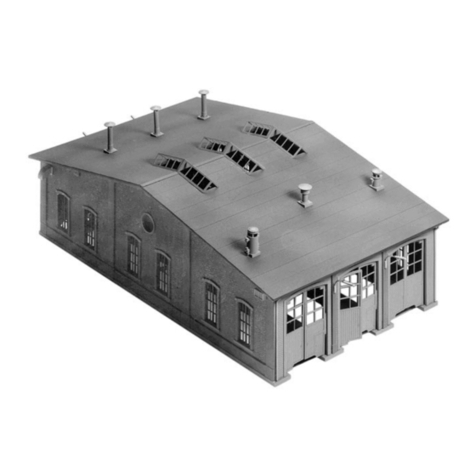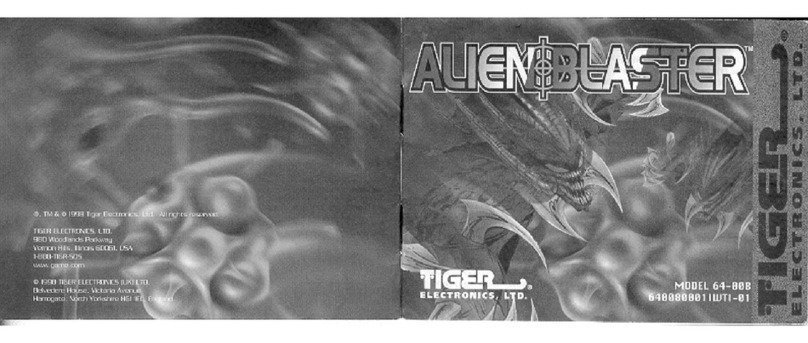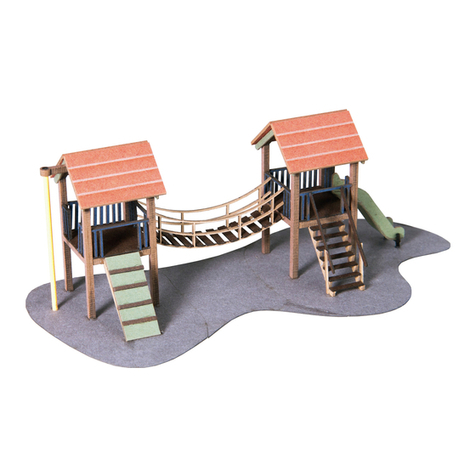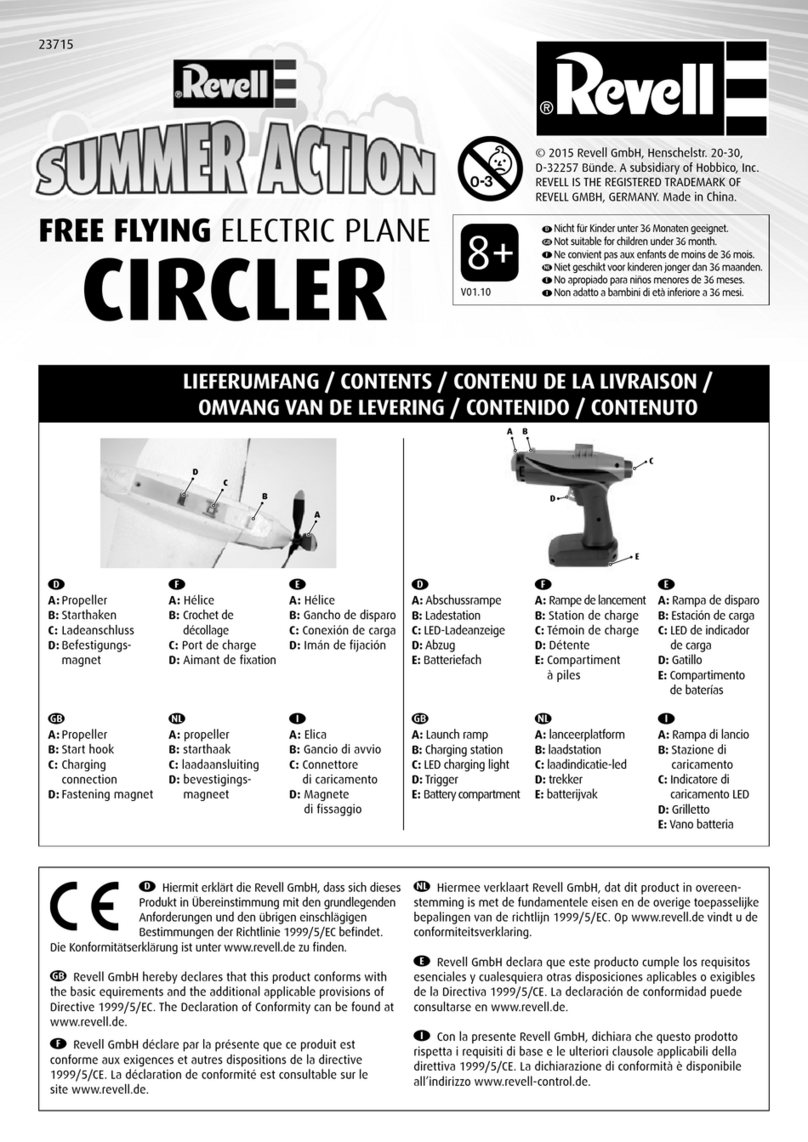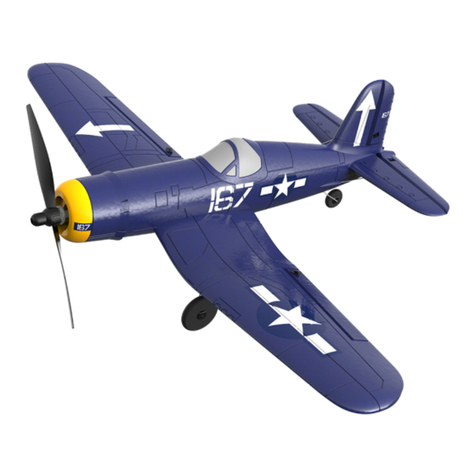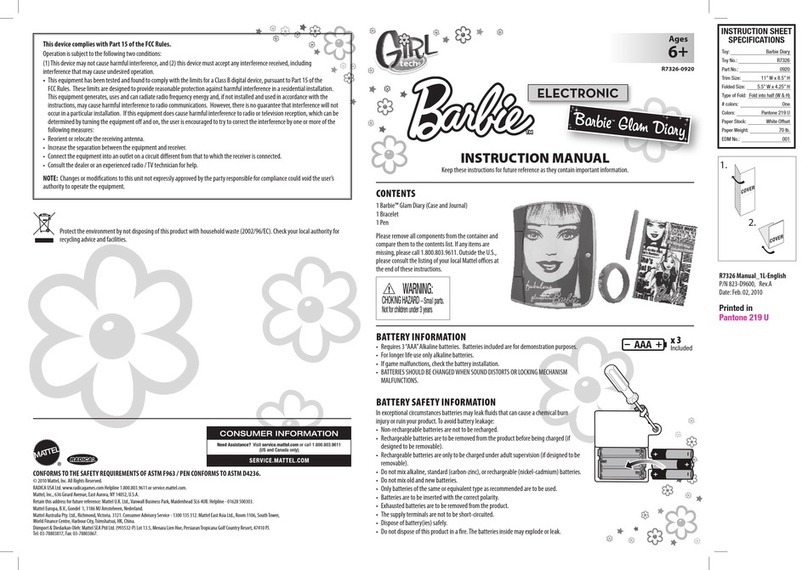Helion AURA 650 User manual

(25.6”)
Specifications
Hull Width 135 mm (5.3”)
Hull Length 650 mm
Mast Height 950 mm (37.4”)
Total Height 1365 mm (53.75”)
Weight 1.35 kg (47.62 oz.)
Batteries 8 AA (included)
Servos Sail winch servo and rudder servo
Instruction Manual
Quick Start Guide

2 / 14
Safety Precautions and Warnings
AGE RECOMMENDATION: NOT FOR CHILDREN UNDER 14 YEARS, THIS IS NOT A TOY
As the user of this product, you are solely responsible for operating in a manner that does not
endanger yourself and others or result in damage to the product or the property of others.
▪ Always keep a safe distance around your model to avoid collisions or injury. This model is
controlled by a radio signal subject to interference from many sources outside your control. Inter-
ference can cause momentary loss of control.
▪ Always operate your model in open spaces away from full-size vehicles, traffic and people.
▪ Always follow the directions and warnings for this and any optional support equipment (chargers,
rechargeable battery packs, etc.).
▪ Always avoid exposing the electronic parts of this model to water. Moisture causes damage to
electronics.
▪ Never operate your model with low transmitter batteries.
▪ Always keep your model in sight and under control.
▪ Always use fully charged batteries.
▪ Always keep transmitter powered on while vehicle is powered.
▪ Always remove batteries before disassembly.
▪ Always keep moving parts clean.
Whether you’re an experienced RC skipper or new to the hobby, the Helion Aura 650 is the
sailboat for you. The Aura 650’s hull is made from durable blow-molded ABS for added
strength and has an attractive pre-applied trim on both the hull and sail that lets it stand out on
the water like a full-size sailboat. It also comes pre-assembled and partially pre-rigged to help
make it easy to get on the water. Plus, the Aura is the ideal size for sailing on nearly any body
of water and small enough to transport back and forth in either the back seat or trunk of your
car.
The Aura 650 is a RTR boat, so everything you need to get started is included in the box -
including a 2.4GHz radio system, a 17 gram “drum style” sail winch servo, and rip-stop nylon
sails that provide durability and great performance. Even the 8 AA batteries (4 for the transmit-
ter and 4 to power the servos) that you need to operate the boat are included so you won’t
have long to wait before you’re tacking your new Aura 650 across a local pond or lake!
MADE IN CHINA
Distributed in the UK by:
J Perkins Distribution Ltd,
Lenham,
Kent, UK
ME17 2DL.
www.jperkins.com
Distributed in Australia by:
Model Engines (Aust.) Pty. Ltd.,
Unit 1, 158-168 Browns Road,
Noble Park,
Victoria,
3174,
Australia.
www.modelengines.com.au
Ph (03) 8793 5555
Distributed in the US by:
Firelands Customer Service/Product Support
1133 Libra Drive, Lincoln, NE 68512
1-800-205-6773
Introduction
Distributed and Serviced by:

3 / 14
.
Box Contents
1
2
3
4
4
4
4
5
67
89
10
11
12
13
14 15 16
17
19
18
20
21
23
22
24
25
26
1. Hull
2. Transmitter
3. Ballast
4. Display Base
5. Keel
6. Short Mast
7. Rudder
8. Backstay Rigging
9. Long Mast
10. Jib Sail w/Boom
11. Main Sail w/Boom
12. HM5x25mm Screw
13. HM5x50mm Screw
14. Luff Rings (3)
15. PWA 2x10x8mm (2)
16. Clip (Rudder)
17. Rubber Gaskets (2)
18. Dyneema Cord
19. Forestay Fitting
20. Cord Holder
21. H2.0mm Allen Key
22. H4.0mm Allen Key
23. Metal Backstay Crane
24. Rudder Arm
25. Clevises (pre-installed)
26. Bowsies (pre-installed)

4 / 14
=
1. Setup the display base as shown in picture.
Insert the tubes into the sockets, no gluing is
required.
Installation and Rigging Guide
2. Setup the keel, water-proof rubber piece and
ballast by HM 5x25mm screw, using a H 4.0mm
allen key.
3. Setup the keel, water-proof rubber piece into
hull by HM 5x50mm screw, using a H 4.0mm
allen key.
4. Insert the rudder from hull bottom to deck
through a rudder arm, connected with a clip,
make sure rudder is able to rotate freely. Then
insert push rod through the connector on rudder
arm, rudder in center position and tighten the
allen screw with a H 2.0mm allen key.
5. Install the cord holder to hull deck with two
PWA 2x10x8mm screws.
6. Unroll main sail and install 1 Luff ring in each
of the three grommets. Slide the long mast through
the Lu rings.

7. Insert long mast through main boom and into
the hull. Ensure the mast screw engages the
main boom slot.
5 / 14
8. Connect long mast, forestay fitting part and
short mast together.
10. Assembly should look like drawing above,
please note that the sail does not need to be
connected to the rear mounts of the swivel.
45mm
210mm
120mm
15mm
65mm
110mm
165mm
9. Raise the sail and place the plastic swivel
on top of the short mast. Insert the metal
backstay crane through the swivel and into
the mast.
Your Aura sailboat comes with the sails already attached to the main and jib boom, these drawings
are only a reference as to the approximate location of the silicone rings.
SR1
SR2SR3
SR4SR5SR6
SR7

11. Locate the approx. 40” long length of
rigging. Attach the clevis to the metal backstay
crane and the other end to the rear eyelet on
the hull. The end with the adjustment bowsie
should be closer to the hull.
12. Unroll the jib sail and untape the clevis
from the top of the sail.
6 / 14
SR5 SR4 SR1
SR2
SR3
13. Unroll the jib sail and untape the clevis
from the top of the sail. Hook the clevis to
the forestay fitting keeping the eyelet
pointing toward the bow of the boat.
14. Unhook the eyelet from the deck hook and
attach it to the front silicone ring on the jib boom.
Slide the bowsie to tighten the line in order to
position the jib in front of the main mast.
15. Untape the line from the jib and thread
it through the 3 deck eyelets as shown in the
drawing above. Slip the loop at the end of the
line onto the clevis that is pre-installed by the
rear hatch and is attached to the winch servo.
16. Untape the line from the main sail and thread
it through the cord holder and 1 deck eyelet as
shown in the drawing above. Slip the loop at the
end of the line onto the same clevis as the
previous step.

7 / 14
17. Now that you have completed the basic assembly of your sailboat, some adjustment of the
rigging may be necessary. Please refer to the instructions below.
(1) Silicone ring 1 on the main boom can be adjusted to tighten the main sail. Leave a little
slack in the sail so that it can catch the wind. Generally, in strong wind conditions the
sail needs more slack and in gentle conditions it can be tighter.
(2) Silicone ring 2 is used to adjust the line length to keep the main boom in center position.
If it is too tight, move it toward SR3. If too loose, move it toward SR1.
(3) Normally SR3 will not need to be moved, it should stay in position over the cord holder.
SR7 SR6 SR5 SR4
18. Some adjustment of the Jib boom rigging may be necessary. Please refer to the instructions
below.
(1) Silicone ring 4 on the jib boom can be adjusted to tighten the jib sail. Leave a little
slack in the sail so that it can catch the wind. Generally, in strong wind conditions the
sail needs more slack and in gentle conditions it can be tighter.
(2) Silicone ring 5 is used to adjust the angle that the jib extends to when the sail winch is
all the way out. Make sure that the jib sail can travel a larger angle than the main sail.
Normally the jib sail travels about 90°-100° while the main sail travels 80°-90°. If the angle
is too small, move SR5 toward SR4. If the angle is too large, move SR5 toward SR6.
5mm - 8mm
30mm - 35mm
(3) If the jib rigging to the winch is too tight move SR6 toward SR5, if too loose move toward
SR7. The jib boom should be able to move about 30-35° when the main sail is fully hauled in
and the sail stick on the transmitter is in its lowest position.
(4) To adjust the distance between the jib boom and the main mast, move SR7. If too large a gap
move toward the counterweight, if too small a gap move toward SR6. There should be about
5mm-8mm gap between jib boom and mast.
90° - 100° 80° - 90°

19. The counterweight on the front of the jib boom is to adjust its balance. It should balance with
the CG (center of gravity) on SR7. Move the counterweight either in or out to make the boom
feel neutrally balanced and moves to either side equally easily.
8 / 14
21. Move bowsie attached
to the jib sail grommet to
tighten or loosen the jib
sail sheet.
22. Move bowsie at rear
of jib sail to tighten or
loosen the jib sail leg.
23. Move bowsie on
foredeck to adjust the
distance between jib
boom and deck.
20. Move bowsie on front
jib sail rigging to maintain a
slight bend in the mast. The
dotted line in the drawing to
the right is an exaggerated
example of the concept the
bow that you will create will
be less pronounced than the
drawing shows.

26. Loosen the screw on
the arm of the main boom
to adjust the height of main
boom. This adjustment is
rarely needed.
9 / 14
LED
Pair Transmitter and Receiver
Pairing (or binding) is the process of programming the receiver
to recognize the GUID (Globally Unique Identifier) code of a
single specific transmitter. When a receiver is bound to a
transmitter, the receiver will only respond to that specific transmitter.
The yacht normally comes with the receiver paired to the transmitter.
If you need to repeat this pairing process for any reason, please
follow these steps:
1. With the transmitter switched ON
2. Power on the receiver, then press the pairing button several
times within 5 seconds.
3. After the receiver LED stops flashing the pairing process is
complete.
4. You are now ready to sail.
Bind Button
Antenna
Loosen this screw
Power - Channel ELEV
Rudder Stick - Channel AILE
Sail Stick - Channel THRO
24. Move bowsie attached
to the main sail grommet to
tighten or loosen the main
sail sheet.
25. Move bowsie on main
sail backstay rigging to maintain
a slight bend in the mast. The
dotted line in the drawing to
the left is an exaggerated
example of the concept the
bow that you will create will
be less pronounced than the
drawing shows.

10 / 14
Transmitter Functions
Sail Stick Move Up
Sail Stick Move Down
Sail Stick Move Up
Sail Stick Move Down
Rudder Stick Move Left
Rudder Stick Move Right
The yacht comes with a 2.4GHz 4-channels radio system. For sailing you will only need 2 channels.
THRO AILE ELEV RUDD MIX
REV
NOR
ON
OFF
SERVO
D/R
0
1
Power LED
Sail Stick
Sail Trim
No Function
Power Switch
Rudder Stick
Rudder Trim
Sail Stick Reverse
Dual Rate Switch
No Function
No Function
No Function
No Function
Rudder Stick Reverse
1. The sail stick controls the angle of the main and jib sails in relation to the hull. When you
move the sail stick up, both sails will be allowed to expand forward to catch the wind.
Both sails can expand to the left or right depending on the direction of the wind.
2. The rudder stick controls the direction of the rudder, left or right.
3. Sail trim/Rudder trim allows adjustment of the neutral position of sail/rudder if needed.
4. Reverse function switches allow individual channels to be reversed. Because a sailing
yacht needs only 2 channels, the reverse switches for channels 3,4 and 5 are not used.

11 / 14
Wind Abeam
Sails: Expand both at an
angle of 45° at port side
Rudder: in center position
Quarter Lee
Sails: Expand both sails
more angle
Rudder: Turn to the left
Starboard Tack-Running
Sails:Expand both sails
at max. angle at both
sides
Rudder: in center position
Port Tack-Running
Sails:Expand both sails
at max. angle at both
sides
Rudder: in center position
Quarter Lee
Sails: Pull back both sails
at starboard side
Rudder: in center position
Luff Up
Sails:Pull backboth sails
gradually
Rudder: Turn to the left
Wind Abeam
Sails:Expand both at a angle
of 45° at starboard side
Rudder: in center position
Luff Up
Sails: Pull back both sails gradually
Rudder: Turn to the left
Port Tack
Sails: Keep pulling back
both sails
Rudder:Keep turning
to center position if the
sails stop flapping
Tack
Sails: Keep pulling back
both sails
Rudder: Turn to the left
Tack
Sails: Keep pulling back
both sails
Rudder: Turn to the right
Tack
Sails: Keep pulling
back both sails
Rudder: Turn to the left
Bearing Away
Sails: Expand both sails
keeping them not flapping
Rudder: Turn to the left
Starboard Tack
Sails: Keep pulling back
both sails
Rudder:Keep turning
to center position if the
sails stop flapping
45°
How-to-sail Instruction
IMPORTANT NOTICE:
1. Never sail your boat in running water such as streams or rivers, as it is easy to lose control.
2. Never swim after a stalled or stuck boat. Wait patiently for the wind to change or increase to free
the boat.
3. After running, remove the hatch allowing the interior of the boat to dry out completely. If you
fail to do this, it may result in corrosion of the electronic components.
Sailing presents a more interesting set of challenges than power boating, it requires a constant reac-
tion to water movement and wind conditions. These reactions require adjustments of both rudder and
sails in order to find the best possible setting for speed and course. There is not substitute for actual
“on-the-water” experience. After a couple of outings you may want to read thorugh the manual again
as you get a better understanding of the art of sailing. While you are learning it is a good idea to gain
some experience with sailing terminology as this will make it easier to understand the concepts
required to master sailing. Study the chart below to understand how wind affects the sailboat and how
to set your sails and rudder to best attack the wind.

12 / 14
Sailing Checklist
Troubleshooting Guide
Problem Possible Causes Solutions
The system is not
connected
Your transmitter and receiver
are too close
Take transmitter 1 to 3 meters away from
receiver
You are around metal objects Try in an area with less metal objects near by
The receiver is not paired to
the transmitter
Repeat the pairing process
The receiver not
responding to the
transmitter
Low battery voltage Replace your batteries with new ones
Loose or damaged wires
between batteries and
receiver
Check the wires and connection between the
battery and receiver.
Repair or replace wires and/or connectors
Boat tends to turn
one direction
Rudder or rudder trim is not
centered
Repair or adjust rudder and rudder trim till the
boat is running straight when rudder stick is in
neutral position
NOTE: This checklist is NOT intended to replace the content included in this instuction manual.
Although it can be used as a quick start buide, we strongly suggest reading through this manual
completely before proceeding.
1. Always turn transmitter on first.
2. Check that the sails, fittings and rigging are properly installed and adjusted.
3. Sail the boat in an appropriate body of water.
4. Switch the dual rates to 100%
5. After sailing, turn receiver power off.
6. Always turn transmitter off last.
7. Drain any water that may have entered the hull. There is a drain plug on the transom.
8. Allow interior of boat to dry prior to storage.

Aura Spare Parts
Firelands
Item Number Item Description
HLNB0100 Aura 650 RTR sailboat
HLNB0101 Painted Hull - White: Aura 650
HLNB0102 Hatch Set: Aura 650
HLNB0103 Pre-Printed Full Sail: Aura 650
HLNB0104 Jib Spare Parts Set: Aura 650
HLNB0105 Main Sail Parts Set: Aura 650
HLNB0106 Electronic Mount Sets: Aura 650
HLNB0107 Dyneema Cord, 5M (2): Aura 650
HLNB0108 Metal Backstay Crane: Aura 650
HLNB0109 Rudder Arm Set: Aura 650
HLNB0110 Rudder & Circlip: Aura 650
HLNB0111 Bowsie (20): Aura 650
HLNB0112 Deck Eyelets & Screws (20): Aura 650
HLNB0113 Mast Full Set: Aura 650
HLNB0114 Clevis (20); Aura 650
HLNB0115 Luff Ring (10): Aura 650
HLNB0116 Silicone Ring (2): Aura 650
HLNB0117 Keel Full Set: Aura 650
HLNB0118 Ballast (Zinc): Aura 650
HLNB0119 Winch Servo Set: Aura 650
HLNB0120 Rudder Push Rod: Aura 650
HLNB0121 Silicon Lead Collar (2): Aura 650
HLNB0122 17g Waterproof Rudder Servo: Aura 650
HLNB0123 Rudder Pushrod Tube (2): Aura 650
HLNB0124 Water Drain Plug (2): Aura 650
HLNB0125 2.4GHz Transmitter: Aura 650
HLNB0126 2.4GHz Receiver: Aura 650
13 / 14

Firelands
Item Number
Item Description
HLNB0100 Aura 650 RTR sailboat
HLNB0101 Painted Hull - White: Aura 650
HLNB0102 Hatch Set: Aura 650
HLNB0103 Pre-Printed Full Sail: Aura 650
HLNB0104 Jib Spare Parts Set: Aura 650
HLNB0105 Main Sail Parts Set: Aura 650
HLNB0106 Electronic Mount Sets: Aura 650
HLNB0107 Dyneema Cord, 5M (2): Aura 650
HLNB0108 Metal Backstay Crane: Aura 650
HLNB0109 Rudder Arm Set: Aura 650
HLNB0110 Rudder & Circlip: Aura 650
HLNB0111 Bowsie (20): Aura 650
HLNB0112 Deck Eyelets & Screws (20): Aura 650
HLNB0113 Mast Full Set: Aura 650
HLNB0114 Clevis (20); Aura 650
HLNB0115 Luff Ring (10): Aura 650
HLNB0116 Silicone Ring (2): Aura 650
HLNB0117 Keel Full Set: Aura 650
HLNB0118 Ballast (Zinc): Aura 650
HLNB0119 Winch Servo Set: Aura 650
HLNB0120 Rudder Push Rod: Aura 650
HLNB0121 Silicon Lead Collar (2): Aura 650
HLNB0122 17g Waterproof Rudder Servo: Aura 650
HLNB0123 Rudder Pushrod Tube (2): Aura 650
HLNB0124 Water Drain Plug (2): Aura 650
HLNB0125 2.4GHz Transmitter: Aura 650
HLNB0126 2.4GHz Receiver: Aura 650
© 2015 Helion
Rev. 1.0 09/15
Table of contents
Other Helion Toy manuals
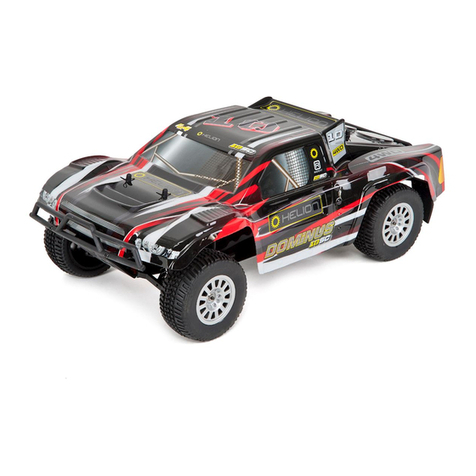
Helion
Helion Dominus 10SC User manual

Helion
Helion Four 10SC User manual

Helion
Helion CONQUEST 10B XB User manual

Helion
Helion Invictus 10MT User manual

Helion
Helion Verdikt User manual
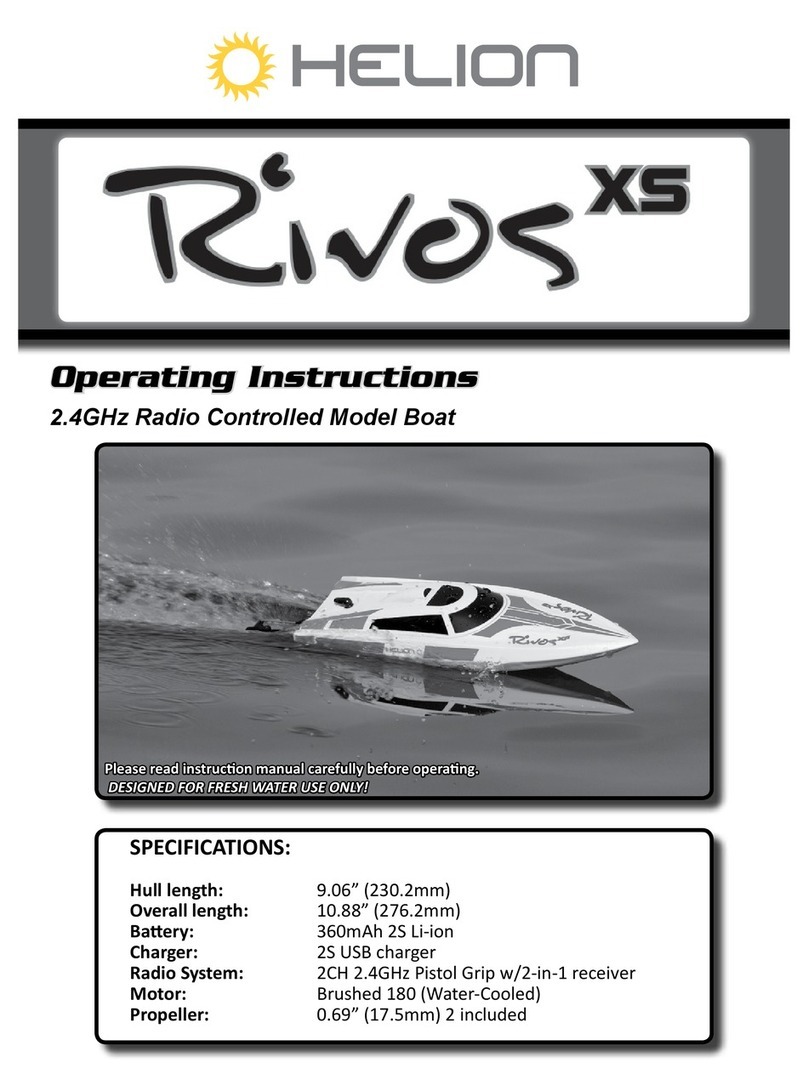
Helion
Helion Rivos XS User manual

Helion
Helion Lagos Sport User manual
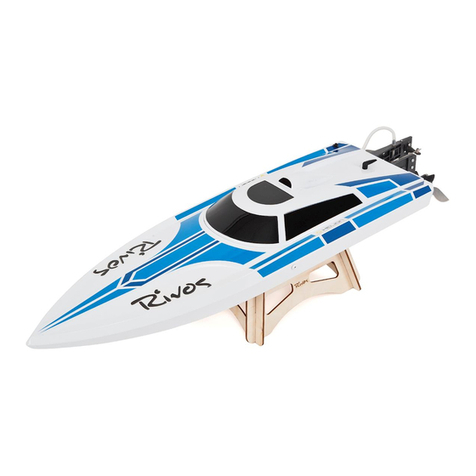
Helion
Helion Rivos User manual
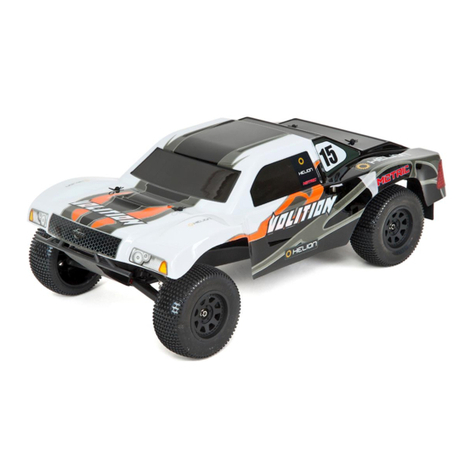
Helion
Helion Volition HLNA0400 User manual
Popular Toy manuals by other brands
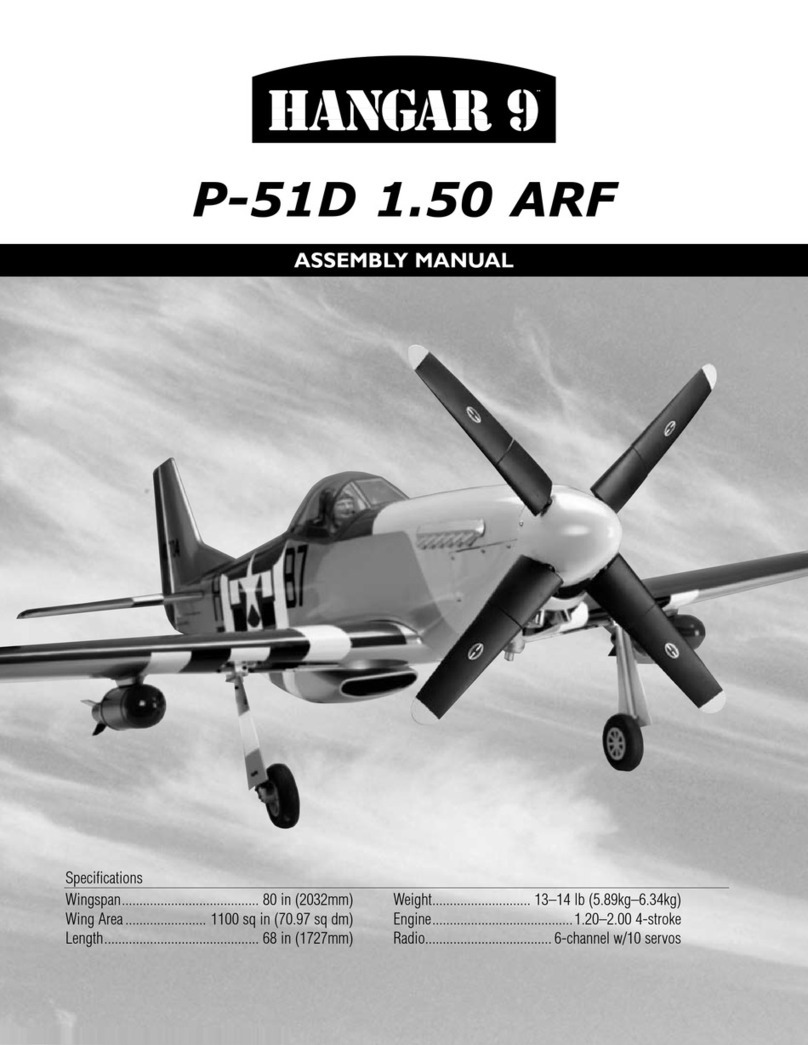
Hangar 9
Hangar 9 P-51D 1.50 ARF Assembly manual
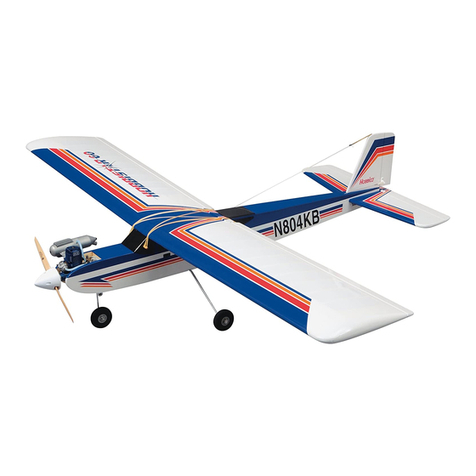
Hobbico
Hobbico Hobbistar 60 Select Assembly instructions
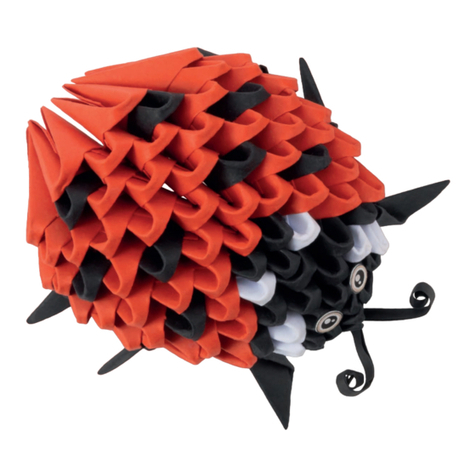
Alexander
Alexander Origami 3D Ladybug 2568 manual
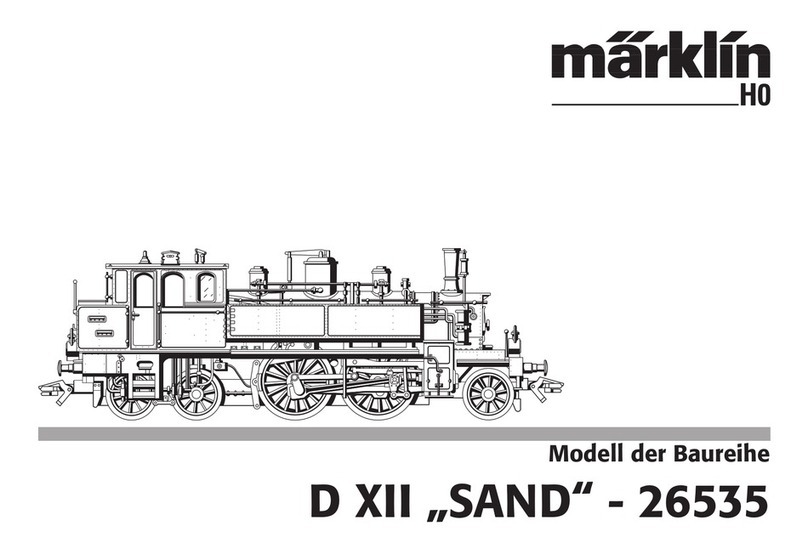
marklin
marklin 26535 user manual
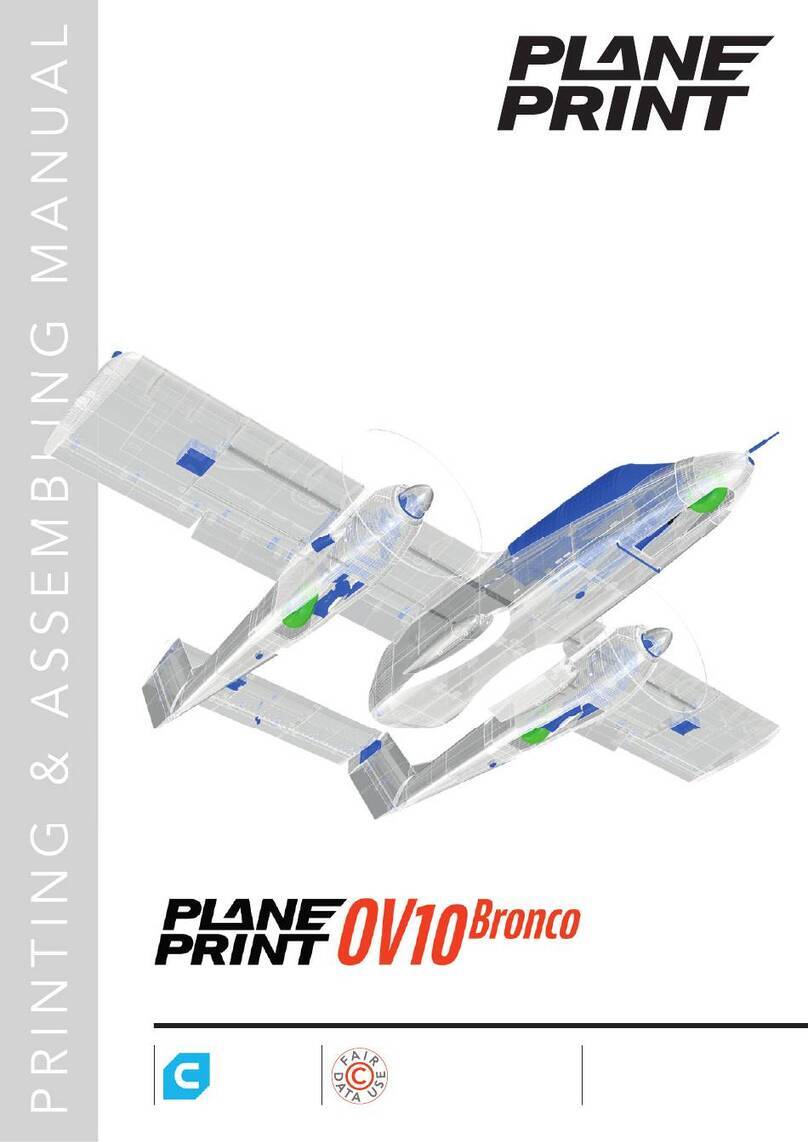
PLANEPRINT
PLANEPRINT OV10 Bronco Assembling manual

Hasbro
Hasbro Marvel Avengers Endgame Titan Hero Power FX... manual
